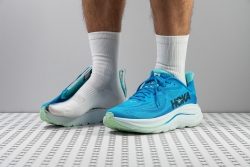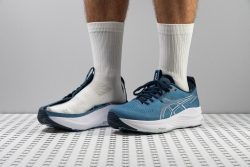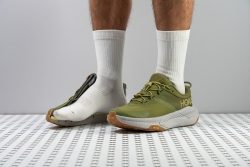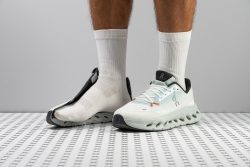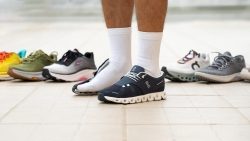7 Best Shoes For Walking And Standing All Day in 2025
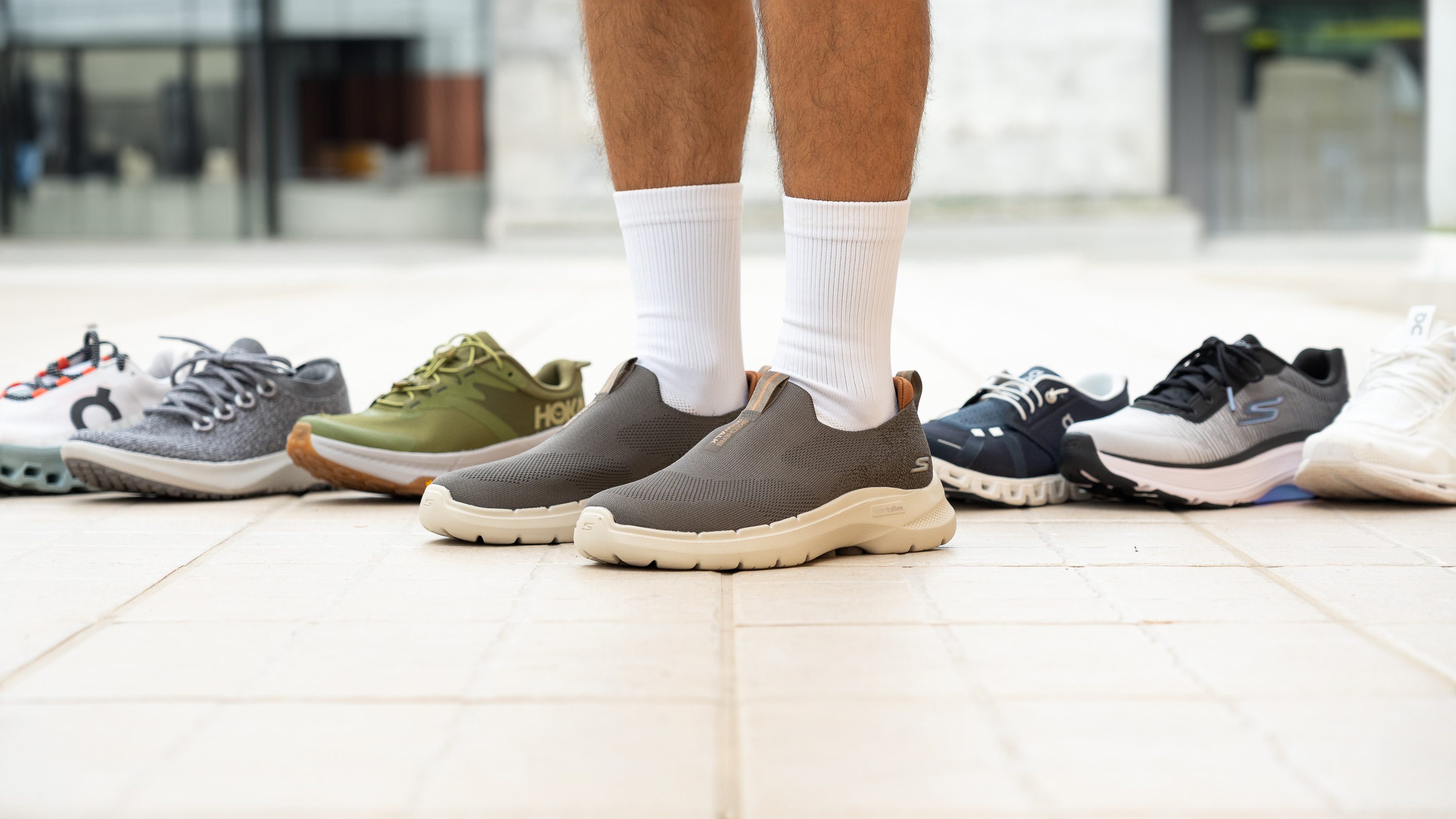
We buy shoes ourselves. We earn commissions when you buy through us, at no extra cost. Why trust us
Shoes for standing all day are not only meant to take good care of your feet but also to keep your entire body supported. Be it an 8-hour shift at work or just a busy day on your feet. Here you’ll find a shoe with all the support and cushioning needed to keep you upright and pain-free.
Maybe you need a sturdy shoe for city walks or a slip-resistant outsole for the kitchen? Or perhaps you prefer extra-plush cushioning or are looking for a budget-friendly option?
We recommend the best models in several categories based on the results of our wear tests and lab tests.
How we test shoes for walking and standing all day
When we are busy at the RunRepeat shoe lab, we spend hours walking and standing on our feet. This is a perfect ground for testing what each walking shoe feels like before we approve it for all-day wear. But it is only part of the equation.
We put each shoe through a series of lab tests and measurements to get the objective numbers on its shock absorption, flexibility, durability, traction, breathability, and more. We even cut the shoes with a saw to further measure their stack height and drop.
Last but not least, we buy every pair of shoes with our own funds to avoid bias towards any brands.
Best walking shoes for all-day wear overall
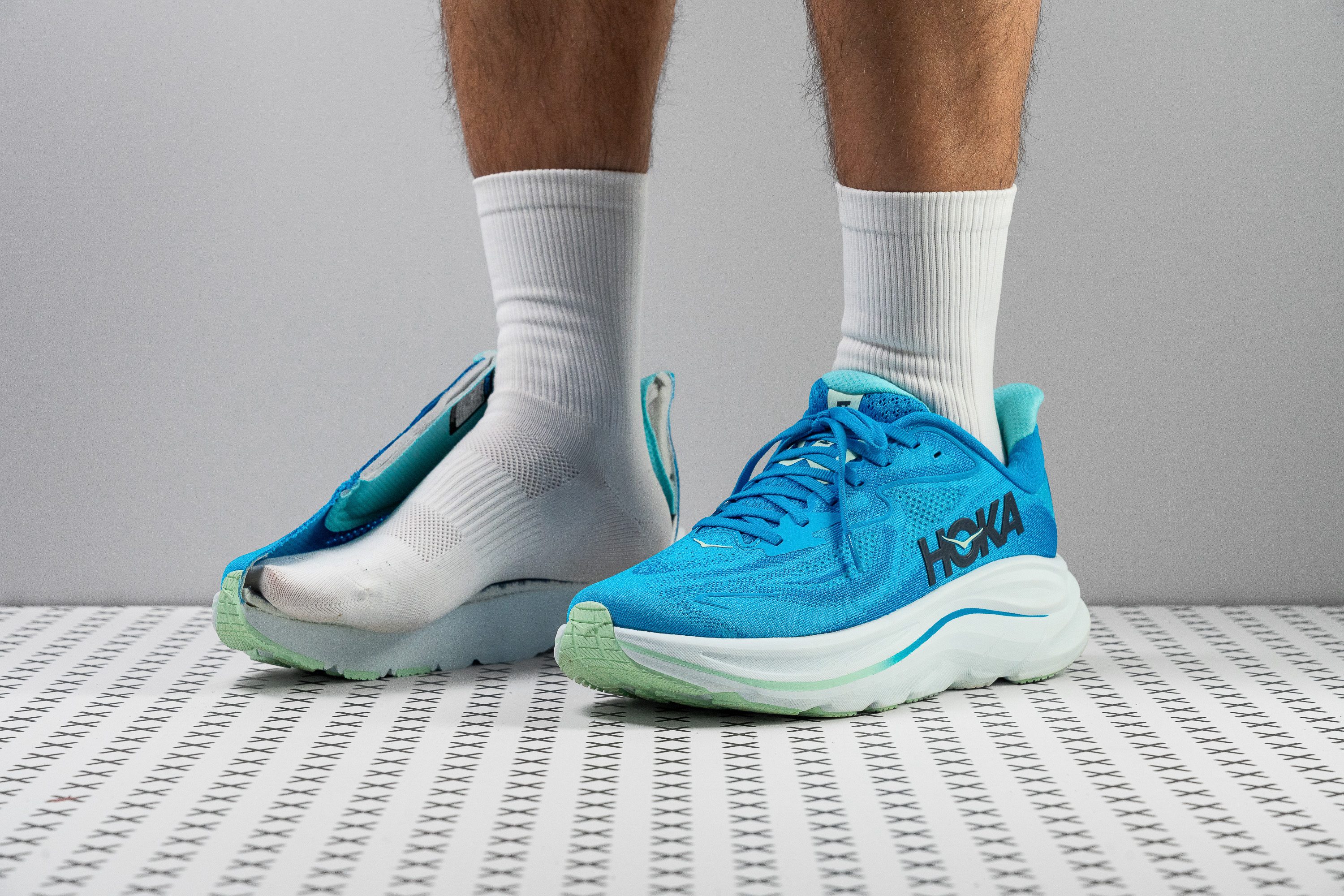


















































What makes it the best?
It’s hard to find a walking shoe that can match the Hoka Clifton 10 for all-day wear. As our ultimate pick in this category, it delivers unparalleled comfort, a reassuring feel, and a forgiving ride. Whether indoors or outdoors, at work or leisure, these shoes provide an exceptional and pain-free experience that makes us forget about time altogether.
Taking our strolls to new heights is the behemoth 44.4/32.0 mm stack made of shock-reducing foam. We were on cloud nine, and our test results confirm sky-high shock absorption levels of 147 SA in the heel and 122 SA in the forefoot. Its leg-saving nature made the miles roll by, erasing ground feedback.
To counteract any ankle collapsing or lateral wobbles, the base is massive at 116.9/94.5 mm. Naturally, this allows us to find our footing more securely and to have better balance within the shoe, especially since it also features high midsole walls for added reinforcements.
Made for all-day and everyday wear, this Hoka flows nicely with our forward movement. In our bend test, it’s slightly more flexible than average at 14.7N, creating a natural and freeing sensation underfoot.
However, we cannot advise Clifton 10 to those who need maximum breathability because the shoe’s limited airflow can lead to heat or sweat buildup in hot weather.
Pros
- Superb joint protection
- Wider toebox improves toe splay
- Comfortable upper
- Stable ride despite its high stack height
- Works well for heel strikers
- Ideal for long runs
- Versatile for daily walking or jogging
- Achilles-friendly heel collar design
- Traction improvements
Cons
- Needs a better foam ASAP
- Notable weight gain from v9
- Feels more Bondi than Clifton
- Non-gusseted tongue
Walking shoes for all-day wear with the best shock absorption
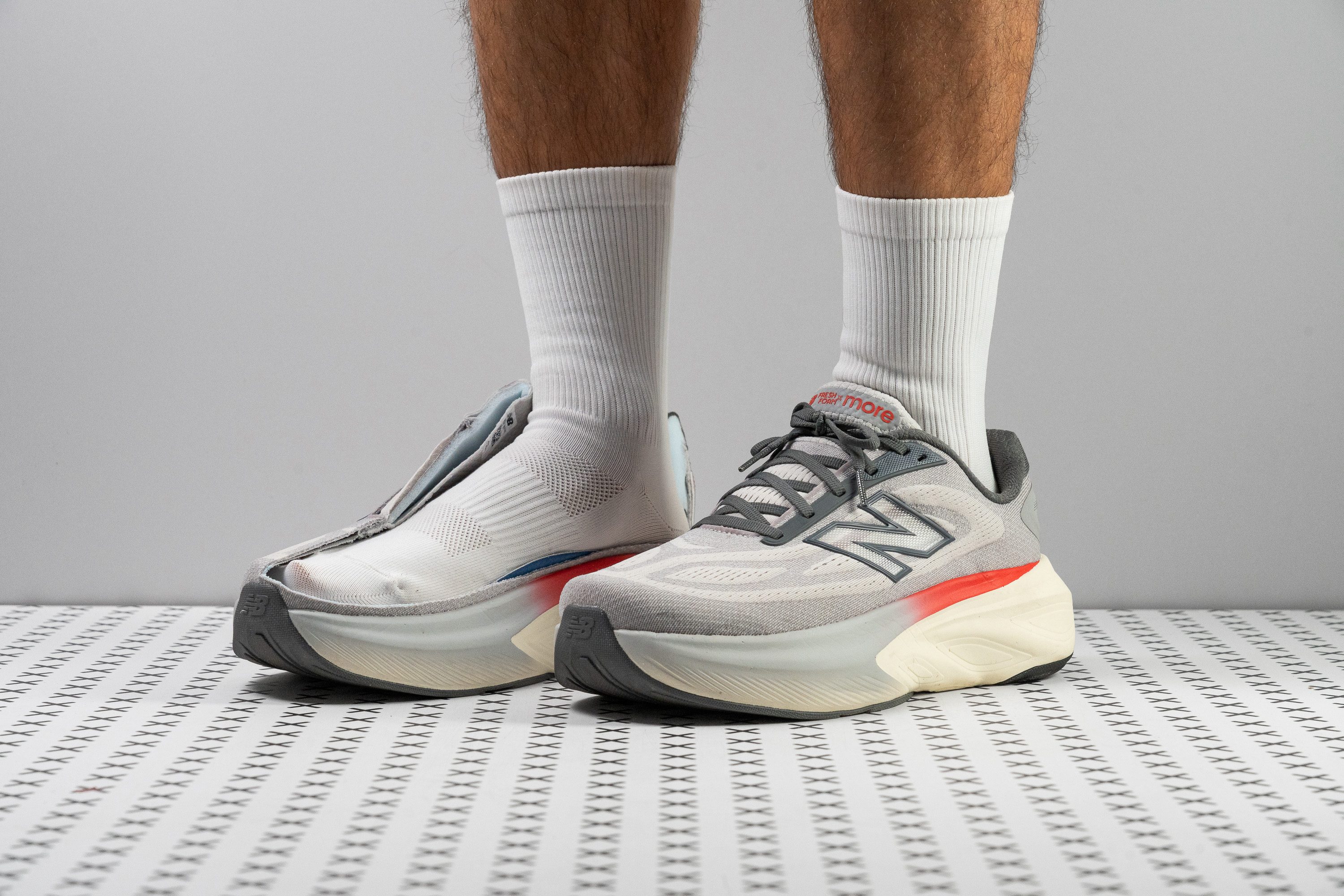













































What makes it the best?
After staying on foot all day and conducting tedious lab tests, we’re sure of one thing: the New Balance Fresh Foam X More v6 delivers comfort to the max, making it our best shock-absorbing all-day wear walking shoe. Its behemoth stack delivers a well-protected ride while featuring a broad platform to stabilize the ride. From daily walks to travels, or long work shifts, its fatigue-reducing midsole does its job effortlessly.
We measured the midsole with our caliper, and our jaws dropped with its 41.8/38.5 mm stack height! We barely felt the ground and loved its plush and soothing persona. Our shock absorption test validates our sensations with an above-average 152 SA score in the heel, reducing the load on our legs by 17.8% vs. average.
While many cushioned shoes sacrifice stability, that isn’t the case for More v6. We felt sure of each step because of the spacious base that gave a well-planted sensation. Our caliper confirms its wide midsole with 122.5/102.0 mm measurements vs. the 114.3/90.8 mm average.
However, this shoe will only feel good in cooler weather. Our feet felt like they were overheating when the temperature started to rise.
Pros
- Record-breaking shock absorption
- Wide platform ensures stability
- Super-plush foam
- Improved energy return
- Cozy upper
- No price hike this year
- Ideal for forefoot strikers
- Solid durability
- Semi-gusseted tongue for secure lockdown
- Good torsional flexibility despite its size
Cons
- Narrow, low-volume interior fit
- Still a heavy shoe
- Weak airflow
- Low drop doesn't work for everyone
Walking shoes for all-day wear with the best stability














































What makes it the best?
Our top stability walking shoe for all-day wear is the ASICS Gel Kayano 32, and our lab test results backed our decision. We discovered its sturdy construction and the 4D Guidance System take away any imbalances while the shock-absorbing cushion promotes foot health, delivering steadfast comfort and dependable strides for hours on end.
One thing we appreciated is how surefooted we felt. The 4D Guidance System supports our arches as they pronate, especially as we lose control when fatigue sets in towards the end of the day. We tried twisting and bending the shoe, but it emerged stiffer than average, evidenced by its 5/5 torsional rigidity and its longitudinal stiffness score, which is 11.2% above average.
Moreover, its tall sidewalls and massive base keep us within the shoe. Our caliper verifies its wide platform measuring 119.8/97.2 mm.
We discovered that GK32 is not only comfortable for all-day travels but also during extended work shifts! Standing long hours on foot felt good because of its stacked and fatigue-reducing cushioning. It earned high shock absorption scores of 133 SA (heel) and 116 SA (forefoot).
However, all its commendable features come at the expense of weight. At 10.4 oz (295g), it’s 11.3% heavier than average. Those who feel burdened by heavy shoes should find another pair.
Pros
- Amazing shock absorption
- Plush and breathable upper
- Made to last
- Dependable for most pronators
- Heavy-duty outsole with excellent grip
- Stable as a table
- Pillow-soft heel padding
- Improved fit
- Excellent build quality
Cons
- Not for soft-foam lovers
- Bad energy return
- Overpriced in Europe
Best city-to-trail walking shoes for all-day wear
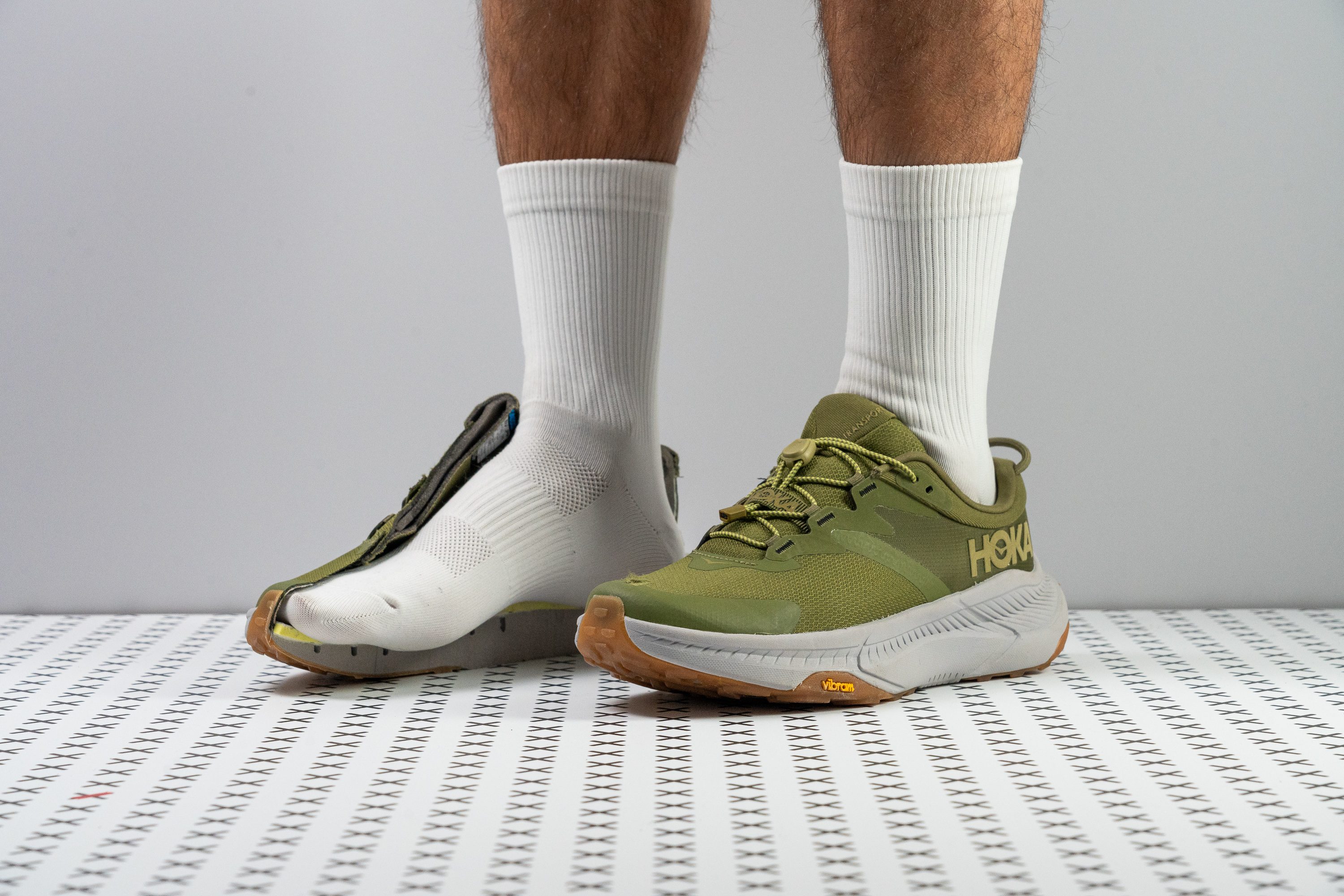





































What makes it the best?
Hoka Transport edged out every other walking shoe in terms of cushioning and overlong wear on the city streets. We found that overall, its footbed is unequal – lushness, softness, and support included. During our round-the-clock travels, exhaustion and discomfort are out of the shoe’s vocabulary!
In our lab, we dove in deeper and sliced the shoe in half, revealing a liberally cushioned Transport. Furthermore, our caliper clocked in heel and forefoot stack heights of 34.1 mm and 26.1 mm, which are thicker than the averages by 3.2 mm and 4.7 mm, respectively.
We were even more pleased when we pressed our durometer to the midsole, as it showed a superb level of softness of 21.9 HA – 25.5% more plush than average. This translated to a phenomenal feel during our extended city strolls.
Even though it is incredibly soft underfoot, this didn’t lead to any wobbliness. Upon investigating, we discovered that Transport’s stiffness led to a stable platform, along with a wide base.
In our lab, we measured the resistance to bending at 18.1N, which is 30.2% stiffer than average. However, for people who prioritize flexibility over everything else, we advise seeking other pairs that allow for more natural bending of feet while walking.
Pros
- Well-cushioned for all-day wear
- Spacious toe box
- Superior traction
- Reliable outsole durability
- Easy to slip in and out
- True-to-size fit
- Easy to clean
- Sustainable
Cons
- Not great for warm weather
- Squeaky during break-in
All-day-wear walking shoes with the best energy return
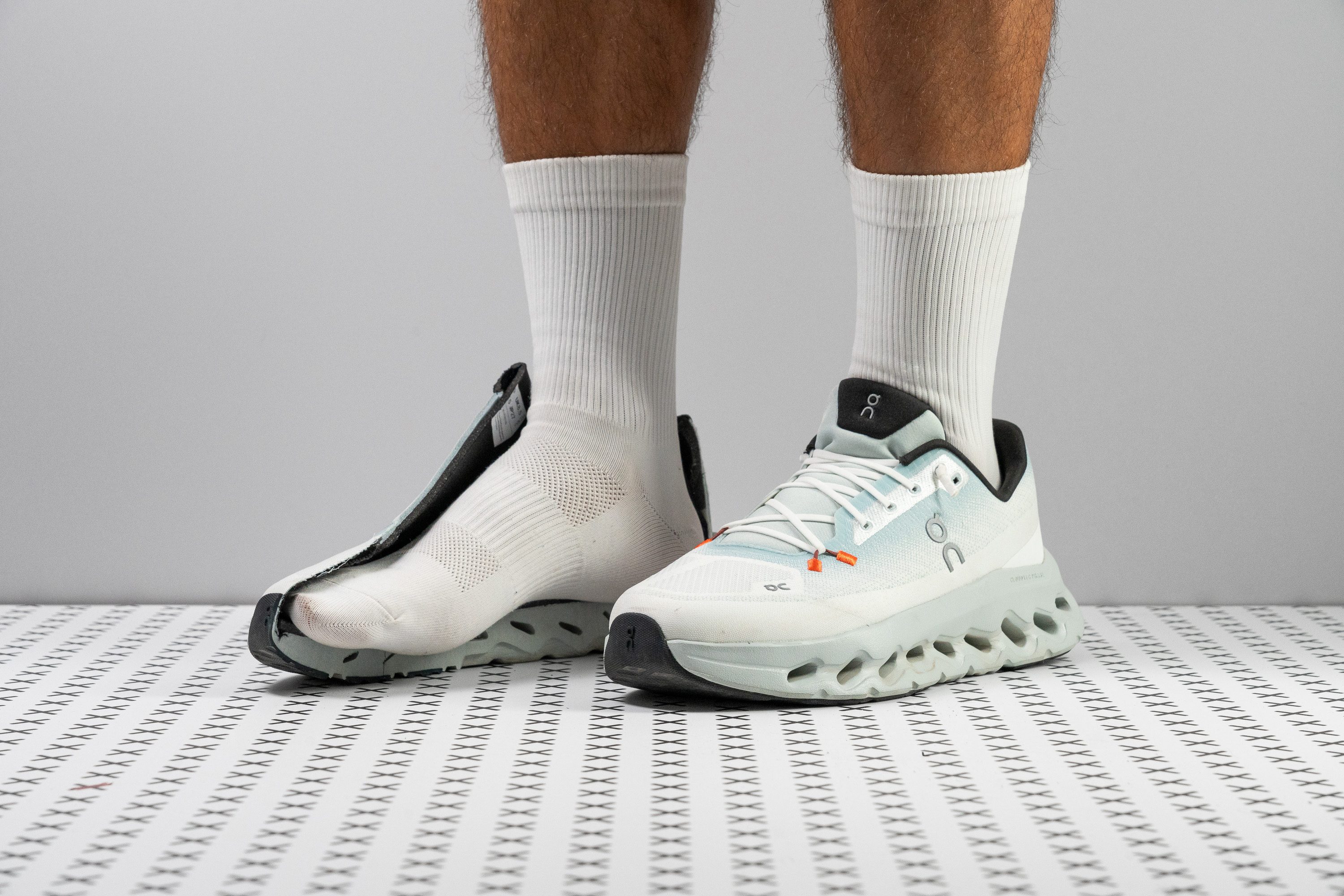






















































What makes it the best?
For all the comfort, bounce, and stability we experienced with our walks in the On Cloudtilt, we’re captivated by its light and springy sensation that had us moving freely without interruptions. Our lab results confirm its responsive midsole while offering a plush and secure feel, making it our all-day wear walking shoe with the best energy return.
Each step was pure bliss with the rebound we experienced. In our energy return test, the heel scored 58.1%, making it 13.9% more responsive than average.
The Cloudtilt offers a freeing experience with its cloudlike figure, validated by its 9.4 oz (266g) reading on our scale, 7.0% lighter than average. Despite its lightness, it doesn’t skimp on cushioning and delivers us with an above-average stack height of 35.5/26.8 mm! Impact protection is unmatched, allowing us to stay longer on foot.
Our shock absorption test validates its gentle touch at 132 SA. With 18.9% better leg cushioning than average, it mirrors how the CloudTec compression enhances comfort. Amazingly, we felt confident throughout because of the wide 117.7/96.7 mm base that keeps us well-balanced.
However, the upper is tightly packed and emerged with a dismal 2/5 breathability score. Those who need excellent ventilation for comfort should find alternatives.
Pros
- Plenty of cushioning for long hours on feet
- Soft yet bouncy ride
- Feels nice and light on foot
- Abrasion-resistant upper and outsole
- Wide and steady platform
- Excellent outsole grip
- Easy on-and-off with bungee laces
- Upper made of recycled material
Cons
- Not very breathable
- Flimsy inner lining and insole
All-day-wear walking shoes with the best traction
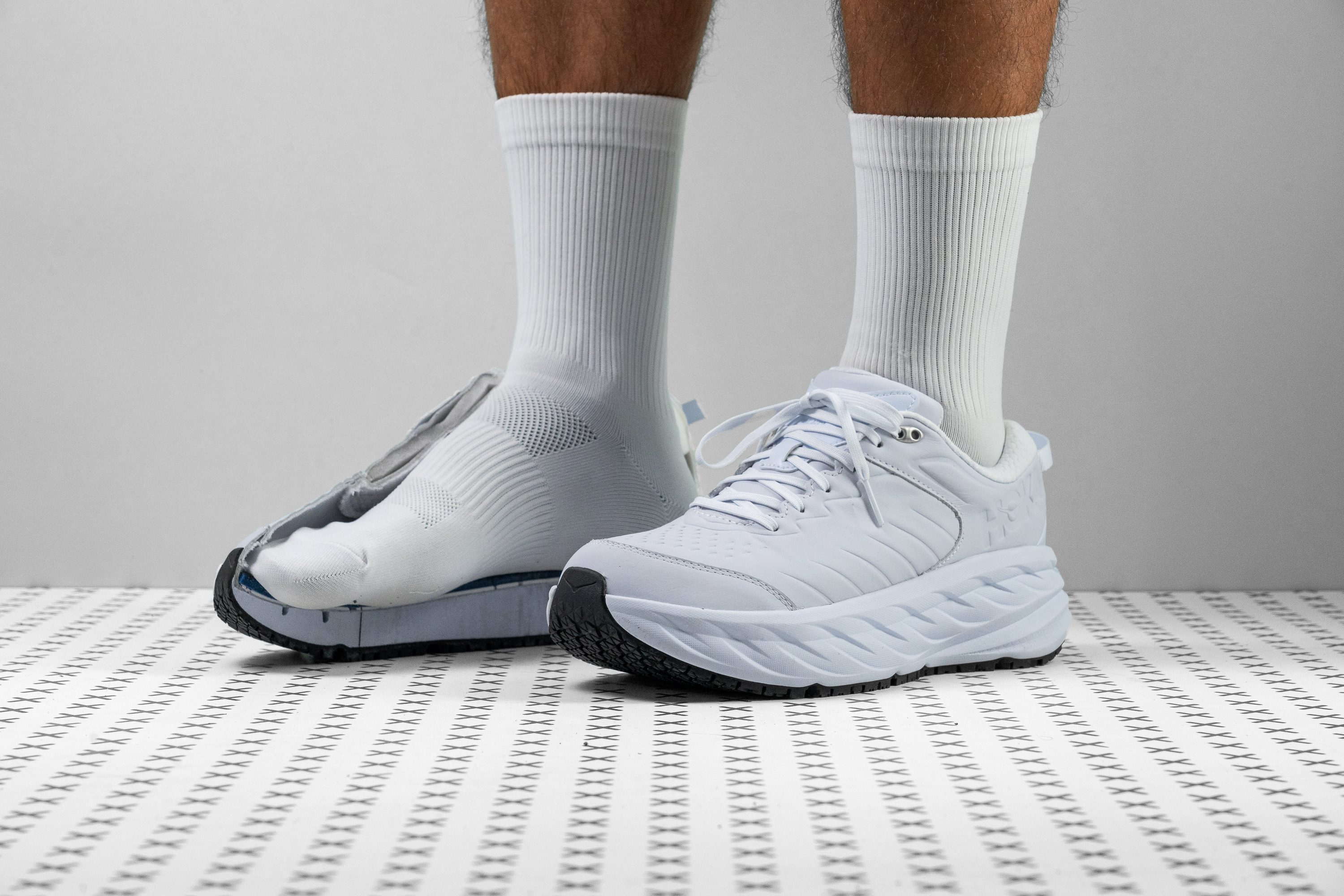










































What makes it the best?
Standing for long hours is something the Hoka Bondi SR could easily handle. Its protective stack feels highly supportive, with a slip-resistant outsole that can handle tiles and wet floors with steady control. Our lab test confirms it offers the best traction among all-day wear walking shoes.
The Bondi SR offers undeniable surefootedness with its sticky outsole. In our wet-condition test, it recorded a high friction coefficient of 0.77! To put things into perspective, its bite is 71.1% stronger than the average!
Beneath us is a mega-stack that feels well-balanced. Our caliper shows it reaches an above-average stack height of 39.4/31.2 mm for comfort. Meanwhile, it recorded a shock absorption score at par with average (111 SA), offering a cushioned experience that relieves leg fatigue.
To counter potential imbalances from its height, the midsole runs wide at 124.1/102.2 mm. It also highly resists twisting, proven by its maximum 5/5 torsional rigidity score. It keeps our feet aligned, and we really felt its support during the latter hours of our shift.
Unfortunately, it tipped the scales to a heavy 14.3 oz (404g). Those who want a lightweight shoe for nonstop walking should try another pair.
Pros
- Comfort is off-the-charts
- Extra thick cushioning for all-day support
- Smooth heel-to-toe transitions
- Alleviates foot discomfort (podiatrist approved)
- Stable for a neutral shoe
- Truly slip-resistant outsole
- Superior material quality
- Water-resistant leather upper
- Accommodating toebox
Cons
- Heavy and bulky
- Not breathable
Best budget walking shoes for all-day wear














































What makes it the best?
Enjoying all-day support with the ASICS GT 1000 14 makes the nine-to-five grind a delight, offering confident stability and adaptive fluidity for only $110! The average stability shoe costs $142, which makes the GT 1000 14 our best budget pick for all-day walking. The lab and the streets witnessed its remarkable balance of rigid and forgiving elements, ensuring our feet were taken care of to prevent discomfort, uneven collapsing, and potential injuries.
Its reinforcing presence felt more reassuring with the 3D Guidance System, which includes high midsole walls, a vast landing base, and a stiff midsole. Our lab reveals a wider-than-average 94.8 mm heel and a midsole that’s twist-resistant with a 4/5 rigidity rating. These elements guide our foot alignment without much intrusion.
Thankfully, its support doesn’t get in the way of forward and foot-bending movement. In our bend test, it emerged 19.1% more fluid than average, making it feel smooth and effortless on foot.
For whole-day trips, maximum ventilation is a must to prevent overheating. However, this shoe falls short with a disappointing 2/5 breathability score in our smoke test. Those who need more airflow should skip this pair.
Pros
- Supercharged stability
- Ideal for heel strikers
- Still offers amazing value
- Fuss-free, durable design
- Improved outsole traction
- Comfortable for everyday wear
- Great step-in feel
- Improved foam from v13
Cons
- Bad breathability
- Still lacks energy return
- Boring ride
Not every shoe can handle all-day wear
Do your day-to-day chores keep you on your feet for hours? Or does your work environment require prolonged standing? In both cases, a high-quality pair of shoes becomes more than just a luxury - it is absolutely essential for your health and well-being!
Working in healthcare, food industry, factories, warehouses, delivery, etc. involves very long bouts of walking and standing which can result in a wide range of unpleasant symptoms in the long run - from fatigue and discomfort to acute musculoskeletal disorders! Research shows that the lower back and feet become the affected areas of the latter.
If you hope to avoid that, we recommend choosing your next pair of daily footwear very carefully.
Just because a shoe has a pleasant step-in comfort and feels nice at try-on, it doesn’t mean that it can support your 10-hour shifts five times a week. There are a few more important characteristics to consider:
- Does the shoe’s cushioning provide enough shock absorption? How soft or firm do you want it to be?
- Does the shoe have enough support, structure, and platform width to keep the foot steady?
- Are there any foot conditions that you need to address with footwear? Flat feet, overpronation, plantar fasciitis, etc.?
- Are you sure that the size and fit are on point? Does the shoe accommodate your foot shape (narrow/wide) or deformities (bunions/Morton’s toe)?
- Does it meet your special workplace requirements (slip-resistant outsole/leather upper)?
- Is it durable enough for the price? Do you need extra thick and wear-resistant materials for longevity?
- Is the shoe breathable enough to keep you sweat-free throughout the day?
That’s a lot to consider…But we’ll take it step-by-step.
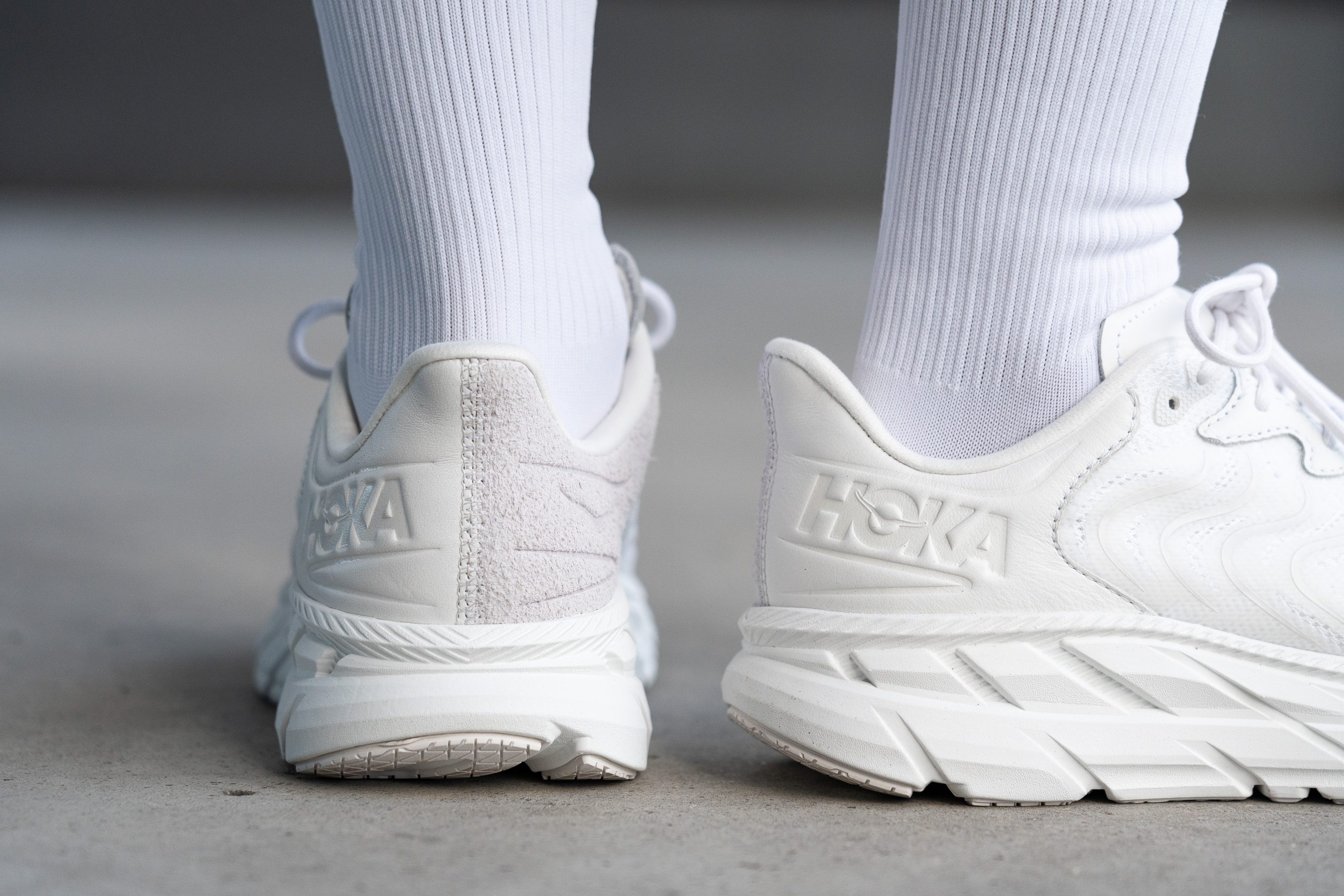
Let’s start with the meat and potatoes of a proper walking shoe which is cushioning and support.
Cushioning: how much do you need for hours of walking and standing?
By cushioning, we imply the shoe’s foam midsole and insole that provide shock absorption underfoot.
Cushioning can be confused with padding, which is the foam inside the shoe's upper (around the collar and in the tongue).
Spending an entire day on your feet puts a lot of stress on your feet, joints, and body overall, but a well-cushioned walking shoe relieves some of it by absorbing the impact forces. We follow the industry's acclaimed ASTM F1976 protocol for measuring exactly how much impact is attenuated by a given walking shoe. The higher the SA measurement, the better the shock absorption.
Having lab-tested hundreds of shoes, we found that an SA reading of 110 in the heel reflects the shoe's ability to maintain impact protection for hours.
The midsole softness of walking shoes varies greatly, going from extra plush to more balanced and very firm options. Even though softer shoes tend to have better SA, it's not always the case.
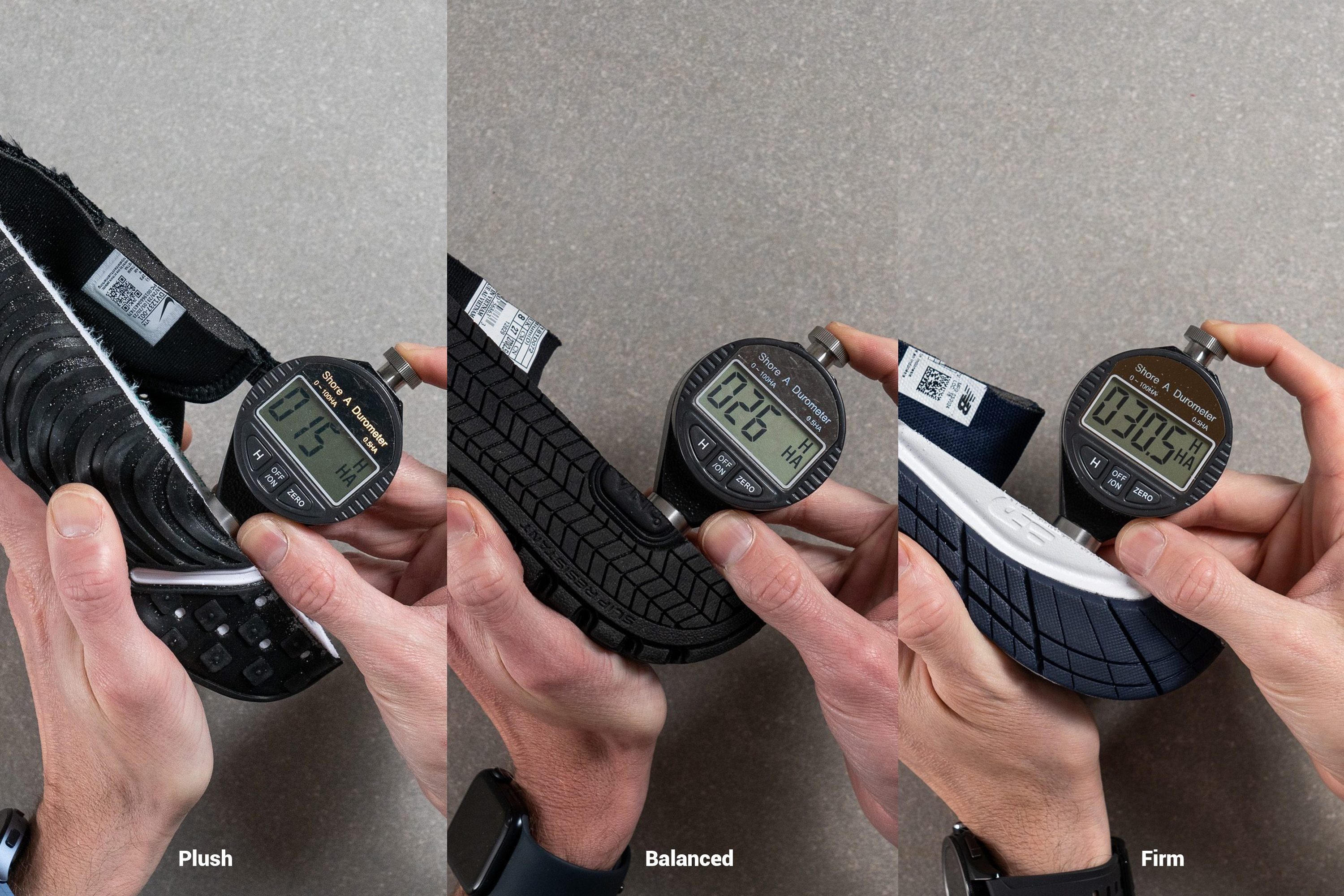
- 20 HA or less: soft
- 20-30 HA: balanced
- 30 HA or more: firm
You are free to choose how soft or firm you want your walking shoe to be. But there are a few reasons why you may prefer one over the other.
Go for softer cushioning if:
- you prefer that cloud-like experience
- you have neutral pronation (no excessive inward rolling of the foot)
- you work on a hard surface like concrete and your facility doesn’t have anti-fatigue rubber mats
Choose firmer cushioning if:
- you want to feel more stable and supported
- you have rubber mats at the workplace
|
How to tell when your shoes lost their cushioning Did you know that cushioning tends to wear out faster than the rest of the shoe? So even if it seems like your shoe is still in good condition from the outside (i.e. the rubber outsole is still intact), it could already be dead inside (as tragic as it sounds). This is possible if:
You might as well try a new version of your shoe in a store to see if the difference is big. Or simply get a new pair of shoes as a replacement and see if your old pair causes too much trouble. In fact, shoe rotation is recommended as a plantar fasciitis prevention strategy in the workplace. And if you don’t think that your old pair is not too beaten up to retire just yet, a pair of high-quality orthotics can prolong its life without compromising your foot health. |
How much shoe support is enough for all-day wear
Look at the two videos below. Which of these shoes would you choose for your work shift?
Walking shoes with less lateral support
Walking shoes with more lateral support
Of course, we are showing two extremes here and there are a lot of shoes that sit in between these two options.
So what are some of the characteristics that make some shoes more supportive than others?
- torsional rigidity
- heel counter stiffness
- midsole width
Torsional rigidity indicates how difficult it is to twist the shoe because of its stiffness.
We perform a manual twist test to assess each shoe’s torsional rigidity on a 1-5 scale (5 is the stiffest).
Here is a simple rule: if you can wring a shoe out like a towel, it’s not supportive enough for hours of standing. That’s why we only recommend shoes with a torsional rigidity score of at least 3 out of 5 for all-day use.
Example of a shoe with the lowest torsional rigidity score (1 out of 5).
The shoe’s heel counter stiffness is another important contributor to support and stability. When the heel counter is stiff, structured, and well-padded, it forms a firm hold around the heel and ankle and locks them down in place. This minimizes wobbling and in-shoe play of the foot and prevents the heel from sliding down the inner side of the shoe.
We assess the shoe’s heel counter stiffness manually on a 1-5 scale with a push-and-squeeze test.
A wide platform is also an integral component of a supportive walking shoe. Having a sufficient landing base to plant your foot not only makes you feel significantly more surefooted but also lowers the risk of rolling the ankle.
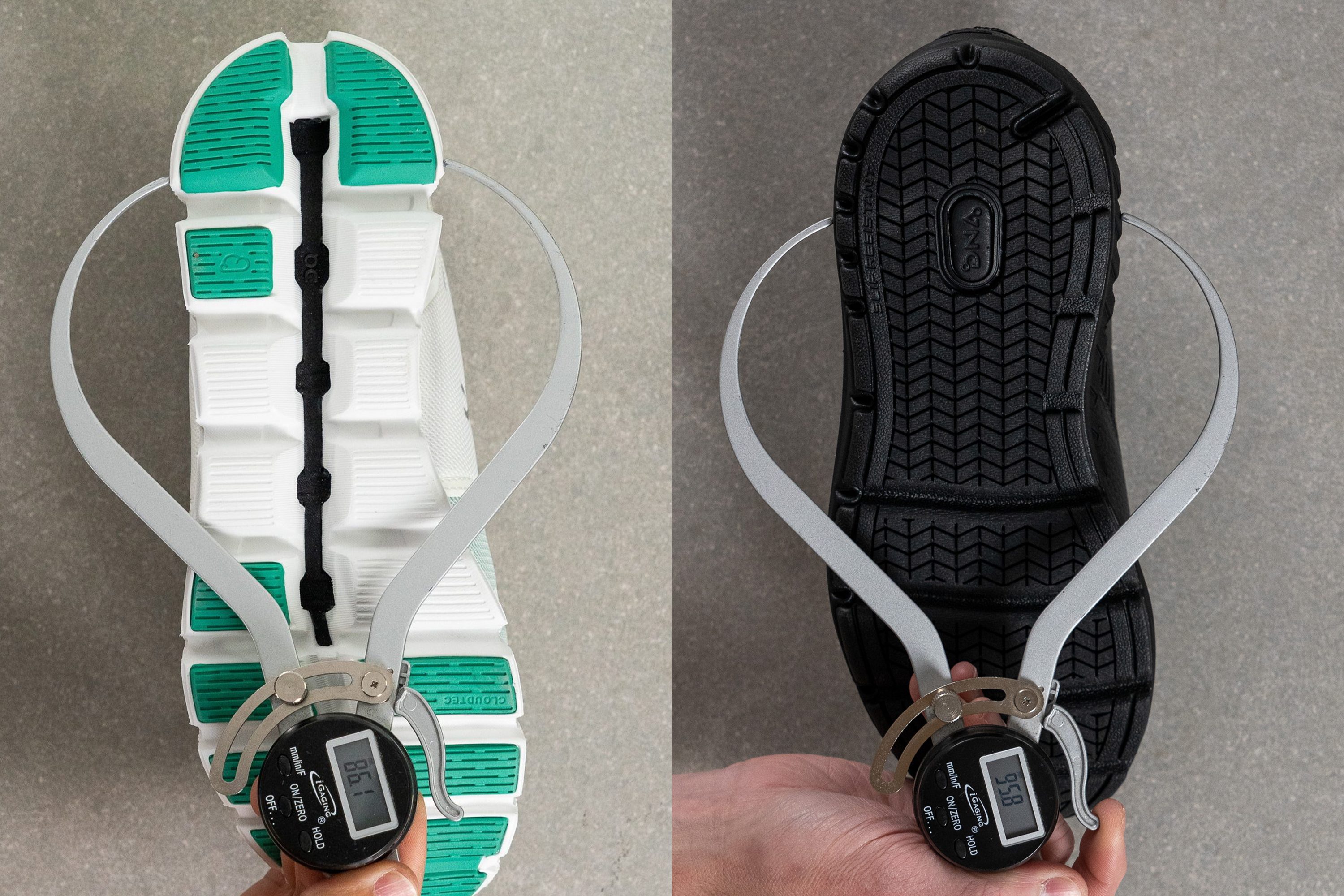
Most walking shoes that made it to our all-day wear shoe list have a heel width of 90 to 100 mm and a forefoot width of 112 to 120 mm in the forefoot (all measured in a men’s US size 9).
The table below features the most supportive walking shoes for walking and standing.
Consider your foot condition (if any)
If you have any footwear recommendations from a doctor or hope to alleviate a nagging foot discomfort, your pair of walking shoes must meet certain criteria.
For example, a shoe for flat feet and overpronation will have additional stability components that prevent the foot from sliding and rolling inwards. A shoe for plantar fasciitis will have a firmer midsole to prevent tendon aggravation. People with obesity will need thicker and firmer cushioning, and so on.
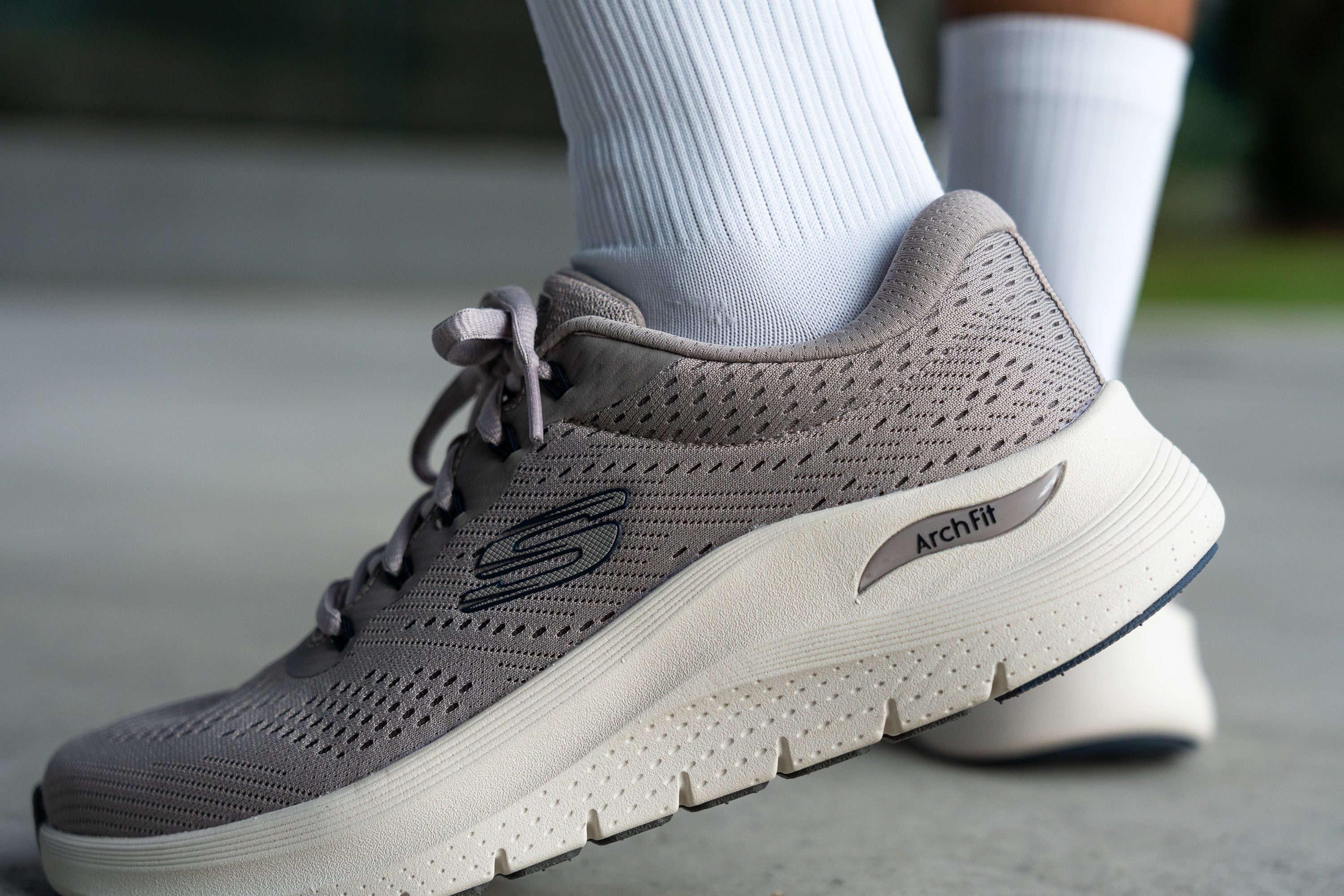
Learn more about the proper type of shoes for different foot conditions in our in-depth guides:
A note on rockered shoes
Following the trend of rockered running shoes, some brands have also experimented with the shape of their walking shoes.
To be honest, we thoroughly enjoyed “rocking” shoes like the KEEN WK400. Our heel-to-toe transitions were extremely smooth and it felt like the shoe forced us to keep going forward. But because of their unconventional design, we can’t include these shoes in our top recommendations for walking and standing.
Can you imagine standing in a shoe like this?
We would also recommend skipping rockered walking shoes if you have any of the following conditions:
- Flat feet and/or overpronation
- Heavy weight/obesity (especially if accompanied by heel pain or arch flattening) because of of the increased overload in the heel and midfoot areas.
This video clearly shows how a rockered sole puts peak pressure on the foot arch.
Can you wear running shoes for walking and standing?
Yes, if the brand recommends them for daily wear. Because a carbon-plated race shoe is a no-no for walking.
Popular running shoe brands like Hoka, Brooks, ASICS, Nike, Adidas, and others tag some of their daily running shoes as suitable for all-day walking, lifestyle, or casual wear.

With decades of experience in underfoot cushioning and support, these shoes are an ideal choice for tackling long hours of repeated forward motion (be it running or walking).
In the table below, we’ve gathered the best running shoes that have all the features you need for prolonged walking and standing. Shoes with higher shock absorption (SA) measurements attenuate more impact and leave your legs fresher for longer, while shoes with higher energy return (%) rebound more of your force back to you (like a trampoline) for a springier ride.
Choosing the right size and fit in shoes for walking and standing
When your long-term comfort and even foot health are at stake, it’s worth investing extra time and effort in finding a truly well-fitting shoe. Especially if you are planning to wear it for 40 hours or more a week!
It is important to consider both the size (length) and width of your next walking shoe.
1. Size: Before you order your usual shoe size, we highly recommend measuring your foot length precisely in millimeters or inches.
That’s because our feet continue to change and grow even in adulthood and a few extra millimeters can actually require sizing up! Once you have the measurement, consult the corresponding size chart to see what size matches your foot length the best in a given brand.
2. Width: If you are someone with wide feet or foot deformities like bunions, you should consider a wide or extra wide width in a walking shoe.
Unfortunately, not all shoes are offered in alternative widths but you can rely on brands like Hoka, New Balance, Brooks, and Skechers to find wider options. Hoka and New Balance even provide detailed measurements for each width in each size to increase your chances of getting the right fit.

The stretchiness of the upper matters as well. Especially if you have those painful hallux valgus (bunion) bumps under the big toe. Research shows that people with bunions found shoes with stretchy uppers even more comfortable than shoes with wide toeboxes.
Special requirements for work shoes
This guide does not cover advanced occupational footwear like steel-toe or comp-toe shoes. But we do include shoes with special features that may be a requirement or a necessity in your workplace.

If you work in healthcare or the food/restaurant industry, you may benefit from a pair of shoes with slip-resistant outsoles. These are tackier than standard rubber and can be identified by a certification of slip resistance (i.e. SATRA).
But we never take these claims for granted and double-check the traction of all walking shoes on our own machine, following the SATRA TM144 method. We expect to see a friction coefficient of at least 0.45 (proving their traction on both dry and wet surfaces), but not all slip-resistant walking shoes live up to that.

Some facilities may require shoes with leather uppers, either for their more protective nature (compared to fabric mesh) or formal appearance.
All-day wear calls for more durable shoes
Especially if you walk on abrasive surfaces like concrete or if you work in delivery and cover many miles per day on urban surfaces like asphalt.
To test how well each shoe is equipped for the demands of all-day walking and standing, we perform a series of durability tests using a Dremel.
With a sandpaper tip attached to it, we apply the tool to each shoe’s toebox, heel padding, and outsole. The exposure time, pressure, and Dremel speed are consistent.
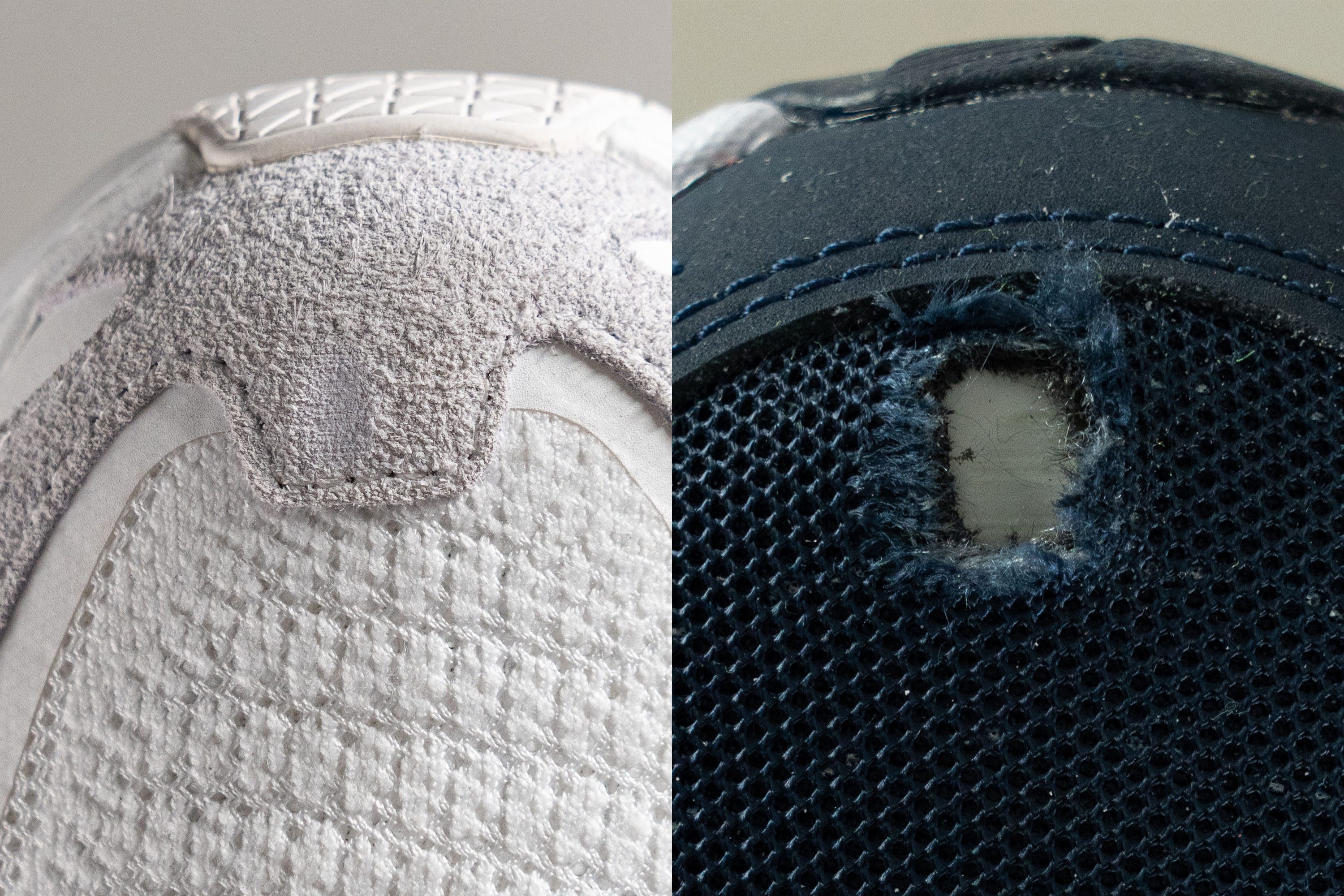

Now here is an interesting question - are more durable shoes always more expensive? Let’s have a look at the table below where we gathered walking shoes with the best durability scores along with their retail price (MSRP).
As you can see, a higher price doesn’t always guarantee better shoe longevity.
Consider breathability as well
Wearing the same shoe for 8-10 hours without changing as you move or stand for prolonged periods of time can turn any shoe into a real sweatbox.
You want to make sure that the shoe you choose for all-day wear has at least some degree of ventilation.
We perform a series of breathability tests on each shoe to let you know which ones have better airflow. This includes pumping smoke into the shoe’s upper, hovering it over the LED light, and examining the fabric under a microscope. In the end, we give each shoe a breathability score of 1-5 where 5 is the most breathable.

